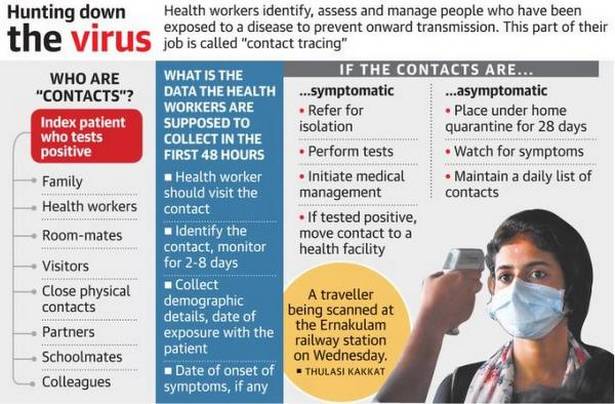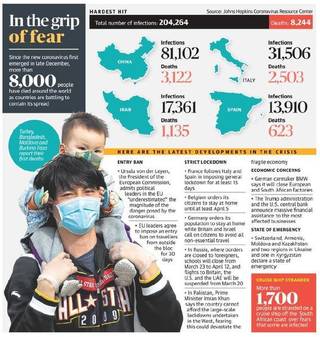Focus: GS-III Disaster Management, Science and Technology, Prelims
Why in news?
- Reported spreading of infection by Coronavirus infected people, to a large number of other people that they came into contact with, makes the issue of tracing contacts very crucial.
- Beginning from the second phase of the epidemic — local transmission — which Indian Council of Medical Research Director-General (ICMR) claims the nation is currently couched in, contact tracing is an integral part of fighting the epidemic on the ground.
- Properly done, contact tracing and follow-up health interventions will ensure that the infection spread is limited and retard or stop the pace of the epidemic to the third stage — community transmission.
What is contact tracing?
- Contact tracing is the process of identifying, assessing, and managing people who have been exposed to a disease to prevent transmission.
- As per ICMR guidelines, which are also directions that have sound public health sense behind them, people who may have been exposed to the virus are to be followed for 28 days from the date of the probable last exposure/arrival from affected countries.
- Any person who has had contact with the index patient under investigation/treatment for suspected, probable or confirmed case of SARS-COV-2, should be monitored for the appearance of symptoms.
Who is a contact?
- Anyone who provided care for the suspect or confirmed case, including a health care worker (including those involved in cleaning, waste management, laboratory technicians, doctors) or family member, or anyone who had close physical contact; anyone who stayed at the same place (lived with, or visited) while the index patient was symptomatic.

- If symptoms appear within the first 28 days following the contact, the individual should be considered a ‘probable’ case and reported through the Integrated Diseases Surveillance Programme network to the National Centre for Disease Control.
Tracing contacts
- As soon as the single event (confirmed SARS-CoV-2) is detected, contact tracing must be aggressively implemented, and preferably to be completed within 48 hours.
- The contact tracing shall preferably be done by visiting the local residence of the contact(s) by a member of the health services team. In certain circumstances or for follow-up, phone calls may be made too, as per the rules.
- On meeting the ‘contact person’, the visiting health worker should explain the purpose of contact tracing and collect data in a prescribed format. It is important to identify the social networks of the first patient and travel history during the 28 days after the onset of illness.
- The patient, his or her family members, colleagues, school or college mates are sources of information about the contacts, as are others with knowledge of the patient’s recent travel and activities.
- Contacts should be traced and monitored for at least 28 days after the last exposure to the case patient for evidence of COVID-19 symptoms to emerge. Case-wise line listing of all exposed contacts will be maintained, with the following information: demographic information, date of last exposure or date of contact with the case patient, and date of onset of fever or other symptoms, if any.
Symptomatic contacts
- Persons who have fever and cough and a history of contact with a confirmed case within the last 28 days should be referwred for isolation for strict infection control.
- Samples must be collected and sent to the designated laboratory for testing, and appropriate wmedical management must begin. If contacts show symptoms, they may be isolated at a health care facility or at home until the results come in. Once confirmed as positive for SARS-CoV-2, they must be shifted to a proper health facility.
Asymptomatic contacts
- They must remain at home (home quarantine) for at least 28 days after the last exposure with the patient. The contacts should start monitoring their health and watch for symptoms of fever and cough, within 28 days of the last exposure to the patient, and maintain a list of people they are in contact with, on a daily basis.
- If he or she develops symptoms, as defined, the contact must wear a mask, self-isolate at home, and inform the local health authority. For 28 days after this, health officials will do an active monitoring of these people.
Health workers
The rules also require the health officials to follow certain precautions while they meet contacts. They are required to maintain a distance of at least two metres from the contact, wear masks, and maintain standard infection prevention and control measures, especially hand-washing.
National Centre for Disease Control
- National Centre for Disease Control (NCDC; previously known as National Institute of Communicable Diseases) is an institute under the Indian Directorate General of Health Services, Ministry of Health and Family Welfare.
- It was established in July 1963 for research in epidemiology and control of communicable diseases and to reorganize the activities of the Malaria Institute of India (MII).
- The NCDC in collaboration with the Centers for Disease Control and Prevention has set up the Global Disease Detection (GDD) Regional Center in New Delhi, India.
- This will lead to long-term public health collaboration between the Government of India and the United States in many areas including establishing high quality research and surveillance on important human infectious diseases, establishing the Indian EIS (Epidemiological Intelligence System) program, and developing the NCDC as an international nodal agency in South Asia.
World grapples with ‘once-in-100-year’ virulence

- Hundreds of millions of people worldwide were adjusting on 18th March 2020, to once-in-a-generation measures to battle the COVID-19 pandemic that is not only killing the old and vulnerable but also threatening prolonged economic misery.
- The fast-spreading disease that jumped from animals to humans in China has now infected about 2,00,000 people and caused over 8,000 deaths in 164 nations, triggering emergency lockdowns and injections of cash unseen since Second World War.
- There was particular alarm in Italy, which has experienced an unusually high death rate — 2,503 from 31,506 cases — and was drafting thousands of student doctors into service before final exams to help an overwhelmed health service.
- Around the world, rich and poor alike saw lives turned upside-down as events were cancelled, shops stripped, workplaces emptied, streets deserted, schools shut and travel at a minimum.
- The crisis has created a wave of solidarity in some countries, with neighbours, families and colleagues coming together to look after the most needy, including dropping supplies at the doors of those forced to stay indoors.



